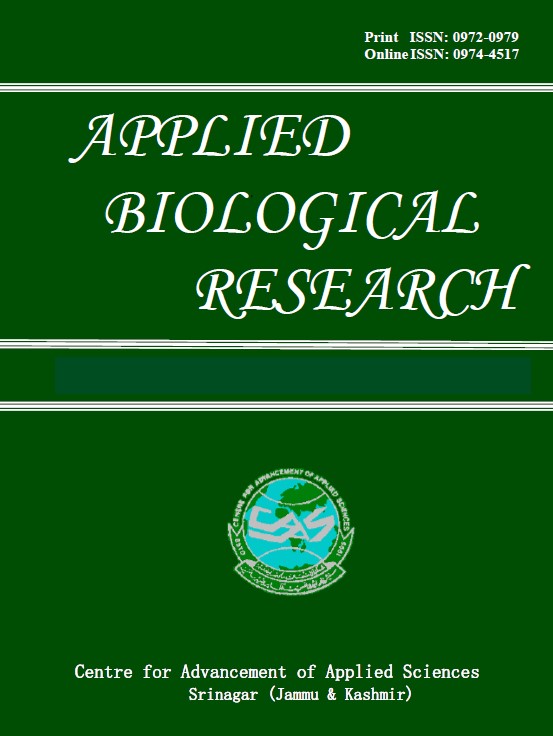DECIPHERING AIRBORNE MICROBIAL COMMUNITIES: LEVERAGING RNA APTAMERS VIA COMPUTATIONAL SLEUTHING
DOI:
https://doi.org/10.48165/abr.2025.27.01.19Keywords:
Airborne microbial communities, Indoor air quality, public health, RNA aptamers, computational modelling, molecular dockingAbstract
Airborne pathogens are a substantial threat to human health; hence, an efficient means to identify these contaminants is necessary to control their spread. The present work focused on developing innovative concepts for employing RNA aptamers to detect biological pollutants in indoor air environments. RNA aptamers are a promising tool for detecting indoor air microbes, thereby enhancing air quality and human health. This study utilized computational methods to identify and characterize RNA aptamer–target interactions. In silico techniques were used to design and predict aptamer sequences capable of binding to various microbial cells present in the air. Based on computational validation, lead aptamer candidates were identified by optimizing and refining sequences to demonstrate strong interactions with multiple microbial targets. RNA aptamer sequences were analyzed for various properties using an oligo-sequence analyzer. Secondary structures were predicted using RNAfold, followed by 3D structure prediction with RNA Composer and docking using the H-Dock server. Interaction modalities were further explored using the PHLIP server. RNA aptamers 1, 2, and 3 showed strong binding affinity scores of –344.95, –331.99, and –395.58, respectively, with target proteins. All aptamers demonstrated robust hydrophobic and hydrogen bond interactions through guanidine phosphate backbone-mediated contacts with Val, Lys, Arg, and Asp residues of target proteins. The in vitro synthesis and in situ environmental validation of these interactions will pave the way for implementing aptamer-based detection in real-time monitoring systems such as healthcare environments, air quality assessment frameworks, and environmental analysis platforms.
Downloads
References
Acharya, B.P., Daniel, R.A., Baridalyne, N. and Gupta, S.K. 2018. Public health emergencies in urban India. Indian Journal of Community Health, 30(1): 18–23.
Alfinito, E., Cataldo, R. and Millithaler, J. 2023. In silico studies of macromolecules as sensors. In silico Approaches to Macromolecular Chemistry, pp. 533–565. [https://doi.org/10.1016/b978-0-323-90995-2.00024-2].
Almazar, C.A., Mendoza, M.V. and Rivera, W.L. 2023. In silico approaches for the identification of aptamer binding interactions to Leptospira spp. cell surface proteins. Tropical Medicine and Infectious Disease, 8(2): 125. [https://doi.org/10.3390/tropicalmed8020125].
Alves Ferreira-Bravo, I. and DeStefano, J.J. 2021. Xeno-nucleic acid (XNA) 2’-fluoro-arabino nucleic acid (FANA) aptamers to the receptor-binding domain of SARS-CoV-2 S protein block ACE2 binding. Viruses, 13(10): 1983. [https://doi.org/10.3390/v13101983].
Annadurai, G., Joseph Mathews, A., Krishnan, E.N. and Simonson, C.J. 2024. A review of experimental methods to determine bioaerosol transfer in energy recovery ventilators. Applied Thermal Engineering, 240: 122322. [https://doi.org/10.1016/j.applthermaleng.2023.122322].
Buglak, A.A., Samokhvalov, A.V., Zherdev, A.V. and Dzantiev, B.B. 2020. Methods and applications of in silico aptamer design and modeling. International Journal of Molecular Sciences, 21(22): 8420. [https://doi.org/10.3390/ijms21228420].
Cataldo, R., Ciriaco, F. and Alfinito, E. 2018. A validation strategy for in silico generated aptamers. Computational Biology and Chemistry, 77: 123–130.
Chawla, H., Anand, P., Garg, K., Bhagat, N., Varmani, S.G., Bansal, T., et al., 2023. A comprehensive review of microbial contamination in the indoor environment: Sources, sampling, health risks, and mitigation strategies. Frontiers in Public Health, 11. [https://doi.org/10.3389/fpubh.2023.1285393].
Couch, G.S., Hendrix, D.K. and Ferrin, T.E. 2006. Nucleic acid visualization with UCSF chimera. Nucleic Acids Research, 34(4): e29. [https://doi.org/10.1093/nar/gnj031].
Dhasmana, A., Uniyal, S., Anukriti, Kashyap, V.K., Somvanshi, P., Gupta, M., Bhardwaj, U., et al., 2020. Topological and system-level protein interaction network (PIN) analyses to deduce molecular mechanism of curcumin. Scientific Reports, 10(1). [https://doi.org/10.1038/s41598-020-69011-0].
Gonzalez-Martin, C. 2019. Airborne infectious microorganisms. Encyclopedia of Microbiology, pp. 52–60. [https://doi.org/10.1016/B978-0-12-809633-8.13002-X].
Goodsell, D. 2011. PDB Pioneers. RCSB Protein Data Bank. [https://doi.org/10.2210/rcsb_pdb/mom_2011_10].
Hameed, S., Xie, L. and Ying, Y. 2018. Conventional and emerging detection techniques for pathogenic bacteria in food science: A review. Trends in Food Science & Technology, 81: 61–73.
Kong, H.Y. and Byun, J. 2013. Nucleic acid aptamers: New methods for selection, stabilization, and application in biomedical science. Biomolecules and Therapeutics, 21(6): 423–434.
Lee, S.J., Cho, J., Lee, B., Hwang, D. and Park, J. 2023. Design and prediction of aptamers assisted by in silico methods. Biomedicines, 11(2): 356. [https://doi.org/10.3390/biomedicines11020356].
Morawska, L. and Huang, W. 2022. WHO health guidelines for indoor air quality and national recommendations/standards. Handbook of Indoor Air Quality, pp. 1–20. [https://doi.org/10.1007/978-981-10-5155-5_49-1].
Navien, T.N., Thevendran, R., Hamdani, H.Y., Tang, T. and Citartan, M. 2021. In silico molecular docking in DNA aptamer development. Biochimie, 180: 54–67.
Oliveira, R., Pinho, E., Sousa, A.L., DeStefano, J.J., Azevedo, N.F. and Almeida, C. 2022. Improving aptamer performance with nucleic acid mimics: De Novo and post-SELEX approaches. Trends in Biotechnology, 40(5): 549–563.
Oliveira, R., Pinho, E., Sousa, A.L., DeStefano, J.J., Azevedo, N.F. and Almeida, C. 2022. Modelling aptamers with nucleic acid mimics (NAM): From sequence to three-dimensional docking. PLOS ONE, 17(3): e0264701. [https://doi.org/10.1371/journal.pone.0264701].
Piva, F. and Giovanni, P. 2006. RANDNA: A random DNA sequence generator. In Silico Biology, 6(3): 253–258.
Salentin, S., Schreiber, S., Haupt, V.J., Adasme, M.F. and Schroeder, M. 2015. PLIP: Fully automated protein–ligand interaction profiler. Nucleic Acids Research, 43(W1): W443–W447.
Stoltenburg, R., Reinemann, C. and Strehlitz, B. 2007. SELEX – A (r)evolutionary method to generate high-affinity nucleic acid ligands. Biomolecular Engineering, 24(4): 381–403.
Vishwakarma, A., Lal, R. and Ramya, M. 2021. Aptamer-based approaches for the detection of waterborne pathogens. International Microbiology, 24(2): 125–140.
Yan, Y., Zhang, D., Zhou, P., Li, B. and Huang, S. 2017. HDOCK: A web server for protein–protein and protein–DNA/RNA docking based on a hybrid strategy. Nucleic Acids Research, 45(W1): W365–W373.

